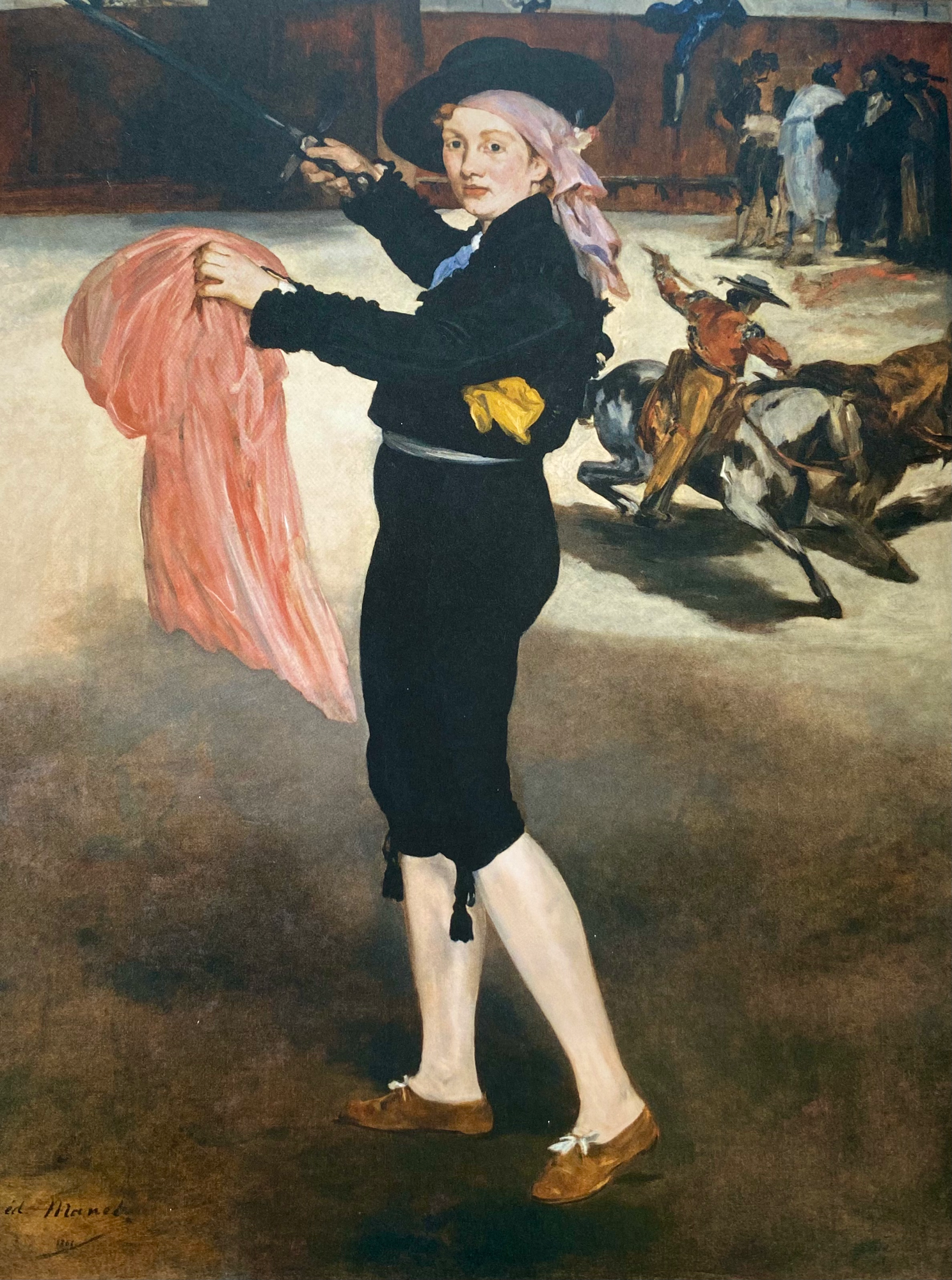Podcast version of this post.
Manet hints at the deeper meaning of his painting in the title Mademoiselle V. in the Costume of an Espada. This masterpiece puts on a show for viewers. We know that partially from the term “costume”. Also, if you’re into Goya, you may recognize this as an homage to his Tauromaquia series. Though it honors the Spanish master’s work, this is no copy. Manet gave his favorite model, Victorine Meurent, a pink rather than a red cape. She’s also shod in footwear that no bullfighter would be caught dead in… bows and all.
Artwork as Performance
Manet doesn’t present Mademoiselle V. in this out-of-context manner just to mess with viewers. He’s reminding us that artwork is performance. In fact, this is my favorite example of a masterpiece that seems to be winking at me. Victorine plays the role of Spanish matador… but she’s half-hearted. Look at how she holds her baton and cape. It’s as if Manet said, “Hold these,” and ended the instruction there. So, she just went with it and as time passed while he was painting her arms drooped from the weight.
LadyKflo’s YouTube Summary
Portrait of the Painter Himself
I’ve heard other theories from art historians and art lovers. For instance, some see Victorine in Mademoiselle V. in the Costume of an Espada as a painter. This scenario points to the matador baton as her paintbrush and the sagging cape bundle – her palette. The idea fits into a subset of the popular notion that artists are essentially narcissists who perpetually paint themselves. I get it. But it’s not my view of Manet. He was an iconoclast with a vision and disrupted gender norms before anybody had a clue what that meant. So, maybe there’s an element of painter to Victorine’s pose. But it’s a bit reductive to sum up the whole masterpiece with this one observation.
The scene Manet sets in this painting makes this portrait into more of a story. At front, Victorine AKA Mademoiselle V. plays dress up as a matador in a posed performance. It’s a playful facade – like a smile that breaks a tense moment with some welcome relief. We know this thanks to Manet’s setting. He distinguishes the foreground from background with a radical difference in painting style.
Conscious and Unconscious
Mademoiselle V. in the Costume of an Espada marries a polished, realistic, portrait with loose and sketchy action at the back. Victorine poses in an awkward stillness, putting on a fanciful show. While behind her we see the raw action of a matador stabbing bulls. There’s a dark story of man versus beast that lives within a bullfight. Men and animals are hurt and even killed in this ring. But Manet sets that at the back, in the recesses of the painting. It’s the fundamental story behind what Victorine plays at. But thanks to Manet’s positioning here, this plot dwells at an unconscious level for the viewer.
This reminds me of how every great performance works on both a conscious and unconscious level. As the audience we know that it’s a show and the performers aren’t actually having these experiences. Yet, in truly great storytelling and acting, we also believe it’s happening and it feels real. That’s our unconscious at work, letting us play a game of pretend for the sake of entertainment.
Meanwhile the actors are delving into their unconscious worlds as well so that they can give us a stellar performance. Manet unearths this sense of showtime in Mademoiselle V. in the Costume of an Espada. It’s what makes this more than just a glorious gender bender in oil on canvas and yet another Manet masterpiece.
Mademoiselle V. in the Costume of an Espada – FAQs
Why did Édouard Manet paint Mademoiselle V. in the Costume of an Espada?
Although we can’t time travel to 1862 or mindread Manet, there are some clues to why he painted Mademoiselle V. in the Costume of an Espada. If you look at Goya’s Tauromaquia series, there’s an evident parallel. So, it’s likely Manet was inspired by Goya’s work when he painted the background for Mademoiselle V.
Manet also loved to play with gender norms and many of his works were quite modern. He dresses his favorite model, Victorine Meurent, in matador clothing and props here. This points to the performative nature of art as well as the pretension of gender norms. Manet was a master of big ideas like this even in the mid 1800s.
Where can I see Mademoiselle V. in the Costume of an Espada in person?
The Metropolitan Museum of Art in NYC houses Manet’s Mademoiselle V. in the Costume of an Espada in Gallery 810. It’s an absolute delight in person. This painting’s almost life size at about 5 X 4 feet. Also, the salmon colored wall sets off Mademoiselle V’s pink cape to perfection. It’s a room of great portraits and this one stands out for the modernity of Manet’s vision. A must-see in person.
Enjoyed this analysis of Mademoiselle V. in the Costume of an Espada
by Édouard Manet?
Check out more essays by LadyKflo on French painters.
Sources
Hamilton, George (1954). Manet and his critics. Yale University Press.
Françoise Cachin, Charles S. Moffett and Juliet Wilson-Bareau, Manet 1832-1883, Paris, Réunion des musées nationaux, 1983
Krell, Alan (1996). Manet and the Painters of Contemporary Life. Thames and Hudson.
Beatrice Farwell, Manet’s espada, vol. 2, New York, Metropolitan Museum Journal, 1969
Stevens, Mary Anne; Nichols, Lawrence W., eds. (2012). Manet: Portraying Life. Toledo: Toledo Museum of Art.
Théophile Thoré-Burger and William Bürger, Salons de William Bürger, 1861-1868, with a preface by Théophile Thoré, vol. 2, t. II, Paris, Jules Renouard, 1870
